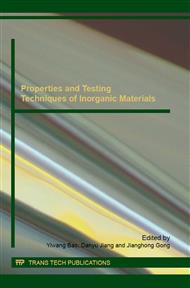p.482
p.486
p.493
p.498
p.502
p.507
p.511
p.515
p.520
Influence of Nitrogen Content on Properties of CrN Coatings Deposited by Single Target Magnetron Sputtering
Abstract:
CrN coatings with different nitrogen (N) content were deposited successfully on the 304 stainless steel, using the single direct-current reactive magnetron sputtering target. The surface and section morphologies, composition, phase structure, hardness and adhesion of CrN coatings were studied systematically by SEM, EDS, XRD, a digital micro-hardness tester and a multi-functional tester for material surface properties. Results indicated that deposition rate of CrN coatings declined with the increase of N2 flow percentage. At the high argon gas pressure, the surface morphology grew via a pyramidal mode, but the surface grain shape of CrN coatings changed from stacking of sheets to looser globular structure to denser texture with the ever-increasing nitrogen pressure in a fixed total pressure. The phases in low N content coating were mostly Cr2N and a small amount of metal Cr while CrN phase existed in high N content coatings, and the crystal preferred orientation changed significantly with the varying N2 flow rates. Appropriate N content can improve the comprehensive performance of CrN coating, the increase of N content contributed to the enhancement of coating compactness and the formation of CrN phase, which can account for the phenomenon that coating hardness improved and coating adhesion dropped weakly when N content was increasing.
Info:
Periodical:
Pages:
502-506
Citation:
Online since:
February 2016
Authors:
Keywords:
Price:
Сopyright:
© 2016 Trans Tech Publications Ltd. All Rights Reserved
Share:
Citation:


